First aid for drowning consists of two parts: rescue from water and resuscitation after rescue from water.
Rescue from the water
- The rescue must be well thought out, but quickly. The rescuer must remain calm and collected. He must be able to manage his own powers wisely, especially if he himself is in danger.
- Try to rescue the drowning person from land first - offer a stick, throw a rope, the end of clothes, a board, a ball or similar. Only if this is not possible, jump into the water.
- T
 ake off your clothes and shoes before rescue.
ake off your clothes and shoes before rescue. - Always approach a drowning person from behind, never from the front.
- Anyone who is not physically strong enough should only start rescuing when the drowning person has become tired.
- If you cannot save a drowning person, know this: one death is the lesser evil than two.
- If the rescue is successful, start resuscitation (CPR) immediately. Call a doctor immediately and remove any annoying persons.
- Only a doctor can determine death.
- In mass accidents, try to rescue only individuals. In crowded conditions, rescue is hopeless.
- After you have brought the drowning person to consciousness, notify emergency medical services as soon as possible.
- Practice rescue and release grips.

The following rules apply when resuscitating a drowning person:
- If possible, the rescuer should start artificial respiration with the mouth already in the water, when he feels the ground under his feet.
- As soon as the drowning person is on dry land, they should be stripped to the hips. By all means, unbutton their collar and loosen their belt. When you notice obstructions in the upper respiratory tract, quickly remove mud, sand or algae from the drowning person's nose, mouth and throat, as well as the dental prosthesis. You should think about the possibility of foreign bodies when you feel resistance when blowing into the airways.
- Do not delay in trying to remove water from the lungs and small bronchi. The water from the nose, mouth, pharynx, windpipe and larger bronchi will drain if you raise the drowning person momentarily at the waist so that the head and chest hang down.
- Place the drowned person on their back, relax the airway and immediately start mouth-to-mouth artificial respiration in adults and mouth-to-mouth and nose in children.
- If the drowned person shows no signs of life, external cardiac massage should be started at the same time as artificial respiration. If the heart does not start beating again and if the drowned person does not start breathing on their own, they need to be resuscitated with artificial respiration and external heart massage until they shows signs of life, until the emergency medical services arrive, or until we are completely exhausted. Only a doctor may stop resuscitation earlier.
- The resuscitation procedure: perform five initial artificial respirations, then continue with heart massage and artificial respiration in a 30:2 ratio. After one minute of resuscitation, call 112 and continue with heart massage and artificial respiration.
- Dress or wrap the drowned person who has gained consciousness in dry clothes or a blanket because they have lost a lot of heat. Observe the drowed person carefully.
- Keep this in mind during transport to the hospital! The danger for the drowned person is not yet over: breathing can suddenly stop again. So keep a close eye on him or her until you give them off to the doctor or hospital.
- Anyone who has been drowning and breathed in some water belongs in the hospital, even if they did not need to be resuscitated. Severe pulmonary complications are possible.
At organized swimming pools, there are virtually no drownings anymore, or their cause is illness (heart attack, epileptic attack) or overestimation of physical abilities.
Related content
Advice for greater safety in and near water
Advice for safe diving
Safety on holidays

